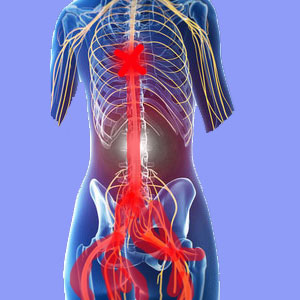
Sciatica and spinal cord injury are often found in patients who are functionally-limited, but still maintain some degree of sensation in the lower body. Many patients with partial paralysis and sciatica suffer terribly, especially if confined to a wheelchair, since this constant seated posture is known to exacerbate many sciatic nerve expressions.
Spinal cord injury comes in many forms and severities. For patients with complete cord injuries, sciatica will not be present, since there is no sensory information being transmitted to the brain from the region of the sciatic nerve. However, for patients with less than total neurological impairment, sciatica is not only possible, but is also rather common, being one of the most reported of all related pain syndromes.
This guide explores the incidence of sciatica in people with incomplete spinal cord injury. We will examine the causes of these painful symptoms, as well as providing specific advice for patients with sciatica and spinal cord trauma.
Causes of Sciatica and Spinal Cord Injury
Lower body radiculopathy or pseudo-sciatica conditions that are found in patients with incomplete SCI can originate from any of the usual sciatica causes. These can include spinal intervertebral disc issues, osteoarthritic processes, spinal stenosis, foraminal stenosis, atypical spinal curvature and vertebral subluxation and slippage concerns in the lower back. Some spinal structural problems can also cause similar expressions in the lower body, even though the causative source is present in the thoracic or cervical spinal regions, as opposed to the lumbar zone.
Non-spinal causes of sciatica are also commonly experienced, and may involve muscular issues, such as imbalances or piriformis syndrome, disease-related processes and mindbody sciatica variants that are related to the psychoemotional genesis of symptoms.
Just because a person suffers from spinal cord injury does not exempt them from being tormented by any of the possible sciatica causes found in the general patient population. In fact, many spinal cord injury victims demonstrate drastically higher rates of many of these causes, making them particularly susceptible to some variations of sciatica.
We have also received reports form some patients with complete cord injury who cited experiences with phantom sciatica in limbs that objectively have no sensory perception. These cases are usually either neurological or of mindbody nature and often are transitory, instead of chronic.
Sciatica and Spinal Cord Injury Concerns
People with spinal cord injury are usually functionally limited to some degree. Some patients have very minor deficits, while others are basically completely incapacitated in large areas of their anatomies. Patients who are confined to bed or wheelchairs cite the worst cases of sciatica, in terms of severity and duration of symptomatic expression. This is no surprise, since these types of physically-confining postures can create sciatica in any person, not just a patient who demonstrates incomplete SCI.
Since cord injury creates a range of problematic health issues, sciatica treatment options might also be limited in effectiveness or indication. Not every therapy will be ideal for a person with SCI and some might be completely contraindicated. However, many forms of traditional and alternative treatment can be utilized in SCI sufferers and may be effective at reducing or eliminating the worst degrees of pain in fortunate individuals.
Being that spinal cord injury sufferers might have other health issues related to autonomic function deficits or internal organ concerns, each treatment must be carefully weighed if it demonstrates risks towards the recipient. This is particularly true for pharmaceutical and surgical interventions used to combat many types of sciatica.
Sciatica and Spinal Cord Injury Can Be a Double Dose of Misery
Either sciatica or spinal cord injury alone can be disabling and lead to dire negative effects on mind and body. However, when combined together, sciatica and spinal cord trauma can leave patients desperate for relief.
Cord injury patients who have a long history of symptoms should consider consulting with a specialist in pain syndromes experienced by people with SCI. There are many physical therapists who focus on these debilitating conditions, as well as other types of specialists who can recommend effectual treatment that will not do more harm than good.
We have reports of some patients finding complete relief from such simple techniques as changing the cushion in their wheelchair or changing their wheelchair choice all together. We have similar reports from patients who are not confined to wheelchairs, but have successfully recovered from severe pain through exercise therapy or other holistic method. We have only a very few reports of patients finding lasting relief using the most common methods of care, including drugs and surgery.
A few patients have written to us over the years pleading for help and reporting that they wished all their sensory ability was eliminated by their injury, just to be free from the pain. Words such as these break our hearts and we have worked diligently to help provide these patients with the professional assistance they need to find symptomatic respite. If you require help with sciatica in association with SCI, please speak to your physician about what can be done to reduce pain and increase functionality, despite the burden of spinal cord damage.





